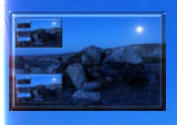|
Quote stuff to start with;
The PG-Rated War
War is a force of primal disorder, but we prefer not to see it that way
I am looking at a photo of a dead American, courtesy of al-Jazeera television network. The boy lies diagonally across the frame, his head in the lower-right-hand corner. His eyes are closed, and there is a bullet hole the size of a half-dollar in his right temple; blood puddles beneath his head and soaks his T shirt. You will not see this photograph on American television or in the pages of this magazine. When word came that al- Jazeera had broadcast this image and others like it, the official U.S. reaction was outrage. When similar photos of dead British soldiers were published, Tony Blair said, "To the families of the soldiers involved, it is an act of cruelty beyond comprehension."
It is that, to be sure. The right to privacy after death in combat should trump all other concerns. There are other good reasons not to show the true face of war, especially when the photos in question are acts of aggression perpetrated by an enemy intent on damaging American morale. But the desire not to sicken or offend the noncombatant public should not be among them. There is real danger when journalists edit the truth, especially when we sanitize the cataclysmic impact of high-powered munitions upon human flesh. There are those who say such images might induce America to become a nation of pacifists, but the exact opposite might be the case. The photo on this page — one of the first images of dead Americans published during World War II, which appeared in the Sept. 20, 1943, issue of LIFE magazine — was intended to incite anger and awareness. It came after Franklin D. Roosevelt decided that the home front had become too complacent, too distanced from the realities of combat, and so he lifted the censorship of American casualties. But the editors of LIFE still felt a need to explain their decision: "Why print this picture? ... The reason is that words are never enough ... the words do not exist to make us see, or know, or feel what it is like, what actually happens ... [I]f Bill" — one of the soldiers in question — "had the guts to take it, then we ought to have the guts to look at it."
The photo, by George Strock, is mesmerizing. There is an unadorned bleakness to it that is unsettling even now, after a half-century of casual, blood-ripped Hollywood action fantasies. And it is far more potent than anything we've seen from Iraq during the first 10 days of the war. This is puzzling. We are closer to war than ever before — hardly half an hour goes by without some embedded ace breathlessly reporting, in real time, from the front. But the war we are seeing is bowdlerized, PG-rated. There are fancy explosions galore, shown from a great distance; there are retired generals wandering through giant maps with pointers and Telestrators; there are gagging doses of Oprah-like human-interest drama, the (slightly) wounded saying "Hi, Mom" and tearful families waiting for word. There are photographs of rubble and of bloodstains that could easily be mistaken for spilled wine. But there is none of the horror, none of the unimaginable sights — bodies torn apart, limbs flying — that cause combat veterans to go mute when asked about their experiences. The coverage of this war is as close to the truth of this war as reality TV is to real life. At a moment like this, the media should be an irritant — shocking us, shaking us, making sure that we're as alert and uncomfortable as possible in the comfort of our living rooms.
War is a force of primal disorder; we are a society afflicted by the illusion of orderliness. We have been so buffered by the carefully demarcated rules of television that we lack the intellectual equipment to deal with chaos (even the events of 9/11 — talk about shock and awe! — were carefully groomed. The most shocking images, the bodies falling from the sky, were generally kept out of view).
Afghanistan, Kosovo, the first Gulf War — each a video game played from 15,000 ft. — only added to our delusion of control. We are not so lucky this time. This is an actual war; there are unplanned events: an unruly enemy, uncooperative allies, magisterial dust storms. That doesn't necessarily mean the war is going badly. For all we know, it may be going splendidly; as I write this, Saddam Hussein may be throwing in the towel.
But we aren't very good at uncertainty; to paraphrase a frustrated American commander last week, we haven't "war-gamed" it. The President himself seemed miffed, sputtering sentence fragments when asked by reporters how long the war would last. Bush has taken to warning us about an extended struggle, but one senses he doesn't believe it. He is, after all, an exemplar of a generation for whom the purest expression of "long" is the television mini- series. He'll have to learn to tolerate the ragged rhythms of armed conflict in the weeks to come, and so will we.
|





